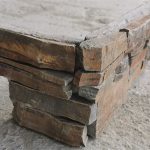Enhancing Your Kitchen with Stone Veneer Backsplash A Comprehensive Guide

Introduction:
The kitchen is often considered the heart of the home, where meals are prepared, memories are made, and families gather together. It is a space that should not only be functional but also visually appealing. One way to enhance the aesthetics of your kitchen is by installing a stone veneer backsplash. Stone veneer backsplashes are a popular choice among homeowners due to their durability, versatility, and timeless beauty. In this comprehensive guide, we will explore everything you need to know about stone veneer backsplashes, from the benefits and types of stone veneers available to the installation process and maintenance tips.

Benefits of Stone Veneer Backsplash:
1. Durability: Stone veneers are made from natural stone materials such as granite, marble, limestone, or slate, which are known for their durability and longevity. A stone veneer backsplash can withstand heat, moisture, and daily wear and tear, making it a practical choice for a kitchen environment.
2. Aesthetics: Stone veneers add a touch of elegance and sophistication to any kitchen space. The natural variations in color, texture, and patterns of stone create a unique and visually appealing look. Whether you prefer a rustic, traditional, or modern style, there is a stone veneer option to suit your aesthetic preferences.
3. Versatility: Stone veneers come in a variety of colors, shapes, and sizes, allowing for endless design possibilities. You can choose from sleek, polished stones for a contemporary look or rough-hewn stones for a more rustic feel. Stone veneers can also be customized to fit any kitchen layout or design scheme.
4. Easy Maintenance: Stone veneer backsplashes are relatively low maintenance and easy to clean. Simply wipe the surface with a damp cloth and mild detergent to remove any spills or stains. Additionally, the non-porous nature of stone makes it resistant to mold, mildew, and bacteria growth, ensuring a hygienic and healthy kitchen environment.
Types of Stone Veneers:
1. Granite: Granite stone veneers are known for their durability and resistance to heat, scratches, and stains. They come in a wide range of colors, from classic black and white to exotic blues and greens, making them a versatile choice for any kitchen design.
2. Marble: Marble stone veneers exude luxury and sophistication with their elegant veining and smooth finish. While marble is more prone to scratching and staining than granite, it can be sealed to enhance its durability and longevity.
3. Roofing slate and insulation properties : Limestone stone veneers have a softer, more natural appearance with subtle variations in color and texture. They are ideal for creating a warm and inviting ambiance in the kitchen.
4. Slate: Slate stone veneers offer a rustic and earthy look with their rich tones and natural cleft surfaces. Slate is highly durable and resistant to water, making it a great choice for a backsplash in a busy kitchen.
Installation Process:
1. Preparation: Before installing a stone veneer backsplash, ensure that the wall surface is clean, dry, and free of any debris. If necessary, repair any cracks or holes in the wall and apply a waterproof membrane to protect the underlying structure.
2. Layout: Plan the layout of the stone veneers on the wall to determine the placement of each piece. Consider the size and shape of the stones to create a visually appealing pattern that complements your kitchen design.
3. Adhesive Application: Apply a high-quality adhesive or mortar to the back of each stone veneer piece using a notched trowel. Press the stone firmly against the wall, ensuring a secure bond.
4. Grout: Once the stone veneers are in place, fill the gaps between the stones with grout using a grout float. Wipe off any excess grout with a damp sponge to achieve a clean and polished look.
5. Sealing: To protect the stone veneer backsplash from stains and moisture, apply a sealer according to the manufacturer's instructions. Sealers can enhance the color and sheen of the stones while providing long-term protection.
Maintenance Tips:
1. Regular Cleaning: To maintain the beauty of your stone veneer backsplash, clean it regularly with a mild detergent and water. Avoid harsh chemicals or abrasive cleaners that can damage the stone surface.
2. Sealing: Depending on the type of stone veneer you have installed, consider resealing the backsplash every 1-3 years to ensure maximum protection and longevity.
3. Avoid Heat Exposure: While stone veneers are heat resistant, prolonged exposure to high temperatures can cause discoloration or damage. Use trivets or hot pads to protect the surface from hot pots and pans.
4. Prevent Staining: Wipe up spills immediately to prevent staining on the stone surface. Consider using a penetrating sealer to repel liquids and maintain the pristine appearance of your backsplash.
Conclusion:
A stone veneer backsplash is a timeless and elegant addition to any kitchen, offering durability, versatility, and aesthetic appeal. Whether you prefer the classic look of granite, the luxurious feel of marble, or the rustic charm of slate, there is a stone veneer option to suit your style and budget. By following the installation process and maintenance tips outlined in this guide, you can enjoy a beautiful and functional backsplash that enhances the overall design of your kitchen for years to come.
